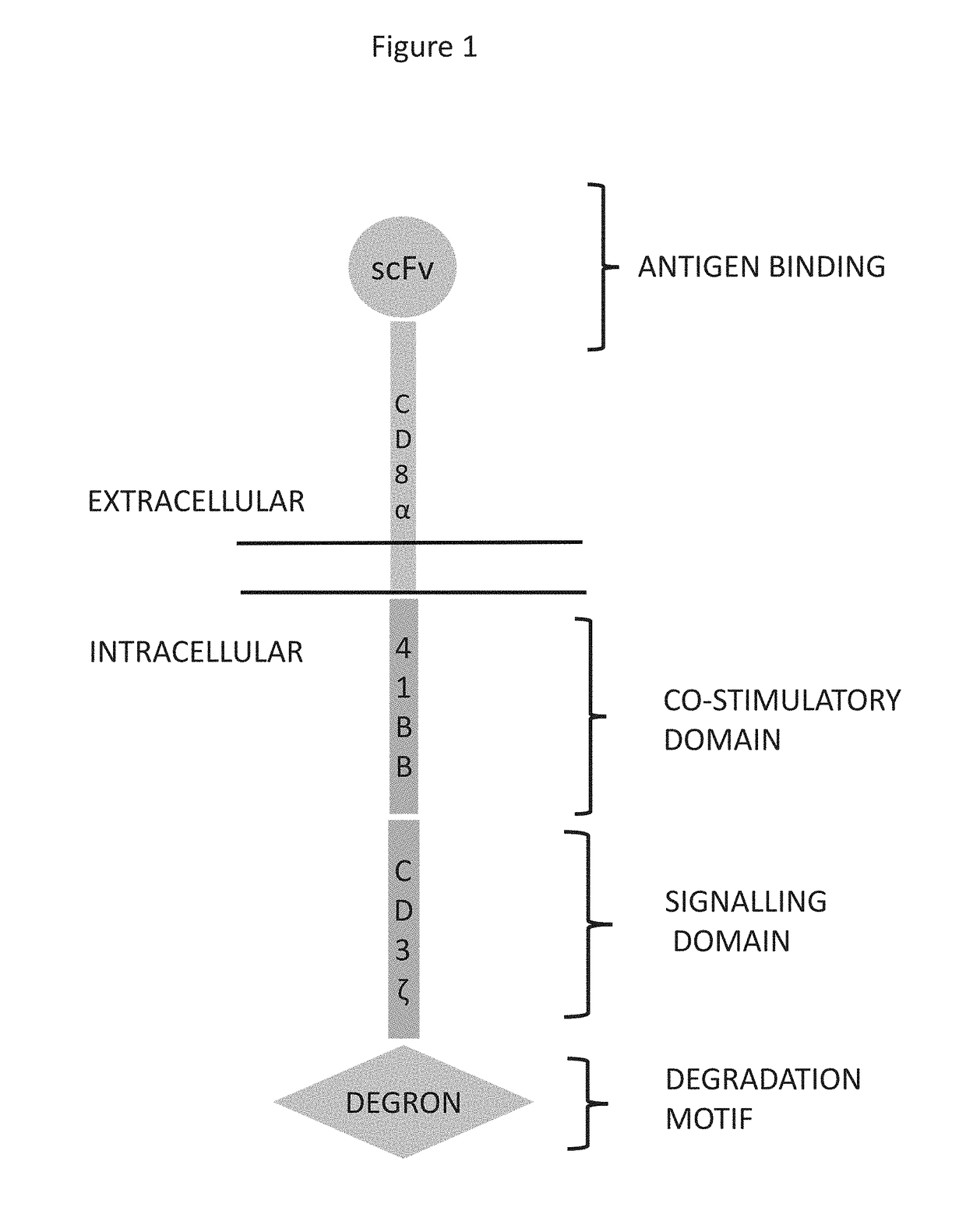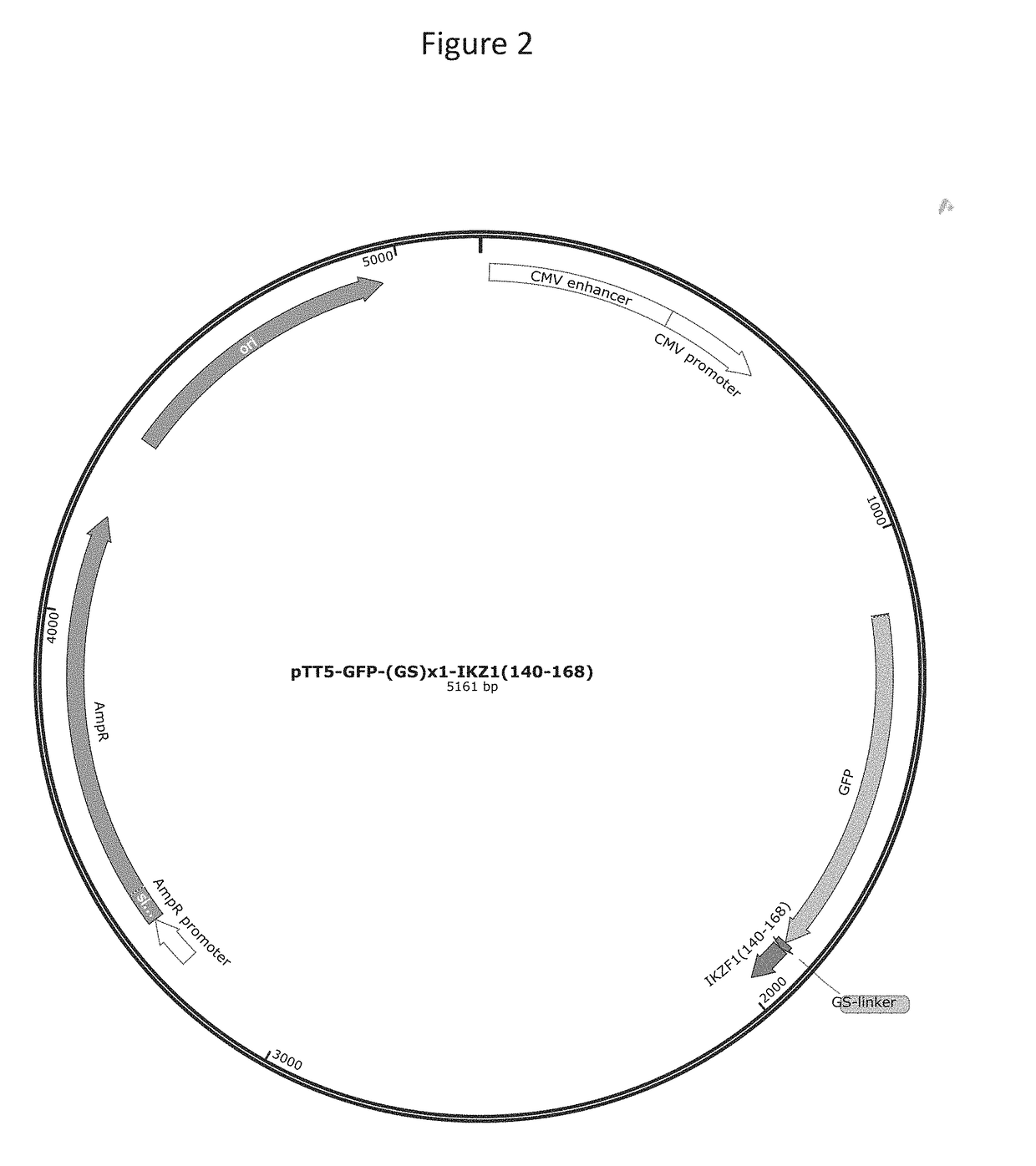Targeted Protein Degradation
a protein and degradation technology, applied in the direction of peptide/protein ingredients, fusion with degradation motif, antibody medical ingredients, etc., can solve the problems of inability to provide prolonged expansion and antitumor activity in vivo, toxicities observed, difficult to predict toxicities,
- Summary
- Abstract
- Description
- Claims
- Application Information
AI Technical Summary
Benefits of technology
Problems solved by technology
Method used
Image
Examples
example 1
Chimeric Antigen Receptors that Incorporate Cereblon Binding Motifs as a Strategy to Build a Molecular Off-Switch
[0244]Constructs have been designed to build a chimeric antigen receptor off-switch using the cereblon binding motifs present in human cereblon targets such as Ikaros3, Casein kinase 1 alpha and GSTP1. Such constructs aim to 1) be degraded by the addition of small molecules such as lenalidomide b) signal as chimeric antigen receptors by the activation of the NFAT pathway in the absence of compound and c) be turned off by the addition of compounds.
[0245]Experiments have been designed to measure the degradation of GFP proteins containing Ikaros3 ZnF cereblon binding regions and the observed structural conservation on the cereblon binding sites of three protein substrates Ikaros3 ZNF2, CK1 alpha and GSTP1:
TABLE 3Cereblon binding sitesSubstrateUniProt IDStructural reference (PDB entries)Ikaros3Q9UKT9PDB entries 2MA7 and 2I13 will be used asZNF2structural representatives of Ik...
example 2
Induced Degradation of Green Fluorescent Protein (GFP) Protein Fused to Ikaros 1 Derived Degron Sequences in HeLa Cells
[0252]This example illustrates the selective degradation of GFP in the presence of lenalidomide. GFP constructs are composed of GFP coding sequence in frame with a (Glycine-Serine)×N linker of lengths N=1, 3, 5 followed by a degron sequence derived from human Ikaros 1. Experiments were conducted with constructs transfected in HeLa cells and degradation was followed by flow cytometry.
Materials and Methods
Generation of Constructs:
[0253]GFP constructs were cloned into pTT5 vector (FIG. 2) fused to a (Glycine-Serine)×N linker of length N=1, 3, 5 and human Ikaros 1 (IKFZ1, Uniprot Q13422) sequence containing residues 141 to 168 (SEQ ID NO:27). Full sequence details of the constructs are given below.
CONSTURCT 1(SEQ ID NO 30)Legend:Linker 4 (SEQ ID NO 26)CONSTRUCT 1 DNA sequence(SEQ ID NO 31)ATGAGCAAGGGCGAGGAGCTGTTCACCGGGGTGGTGCCCATCCTGGTCGAGCTGGACGGCGACGTAAACGGCCACAAGTTCA...
example 3
Induced Degradation of Chimeric Antigen Receptor (CAR) Constructs Transfected in Jurkat Cells
[0257]This example illustrates the selective degradation of CAR constructs in the presence of lenalidomide. Experiments were conducted by transfection of the CAR constructs in Jurkat cells.
Materials and Methods
Generation of Constructs:
[0258]Two constructs were generated to evaluate the effect of lenalidomide on the regulation of the expression levels of a receptor (CAR). CONSTRUCT 4 is a conventional CAR with an antigen recognition scFv that binds to and is activated by the B-cell maturation antigen BCMA (Uniprot Q02223). The scFv is followed by human CD8a hinge and transmembrane domain, human 4-1BB co-stimulatory and the human CD3 intracellular domains (FIG. 1). CONSTRUCT 5 contains the same elements of CONSTRUCT 4 plus the C-terminal end addition of two sections of the human Ikaros 3 protein (Uniprot Q9UKT9). The first section comprises residues 131-175 (SEQ ID NO:27) and is followed by a ...
PUM
| Property | Measurement | Unit |
|---|---|---|
| size | aaaaa | aaaaa |
| Phi angles | aaaaa | aaaaa |
| Phi angles | aaaaa | aaaaa |
Abstract
Description
Claims
Application Information
 Login to View More
Login to View More - R&D
- Intellectual Property
- Life Sciences
- Materials
- Tech Scout
- Unparalleled Data Quality
- Higher Quality Content
- 60% Fewer Hallucinations
Browse by: Latest US Patents, China's latest patents, Technical Efficacy Thesaurus, Application Domain, Technology Topic, Popular Technical Reports.
© 2025 PatSnap. All rights reserved.Legal|Privacy policy|Modern Slavery Act Transparency Statement|Sitemap|About US| Contact US: help@patsnap.com



